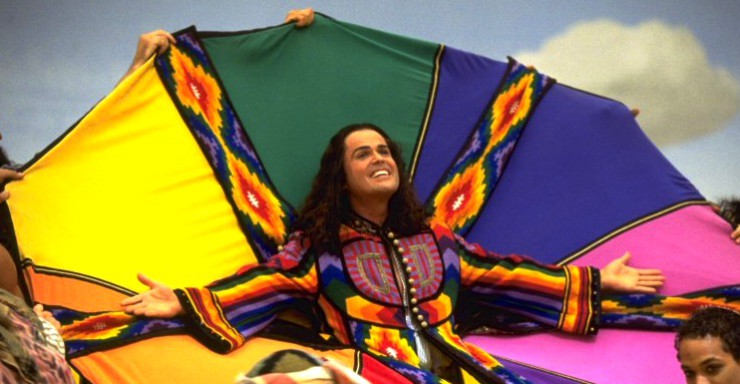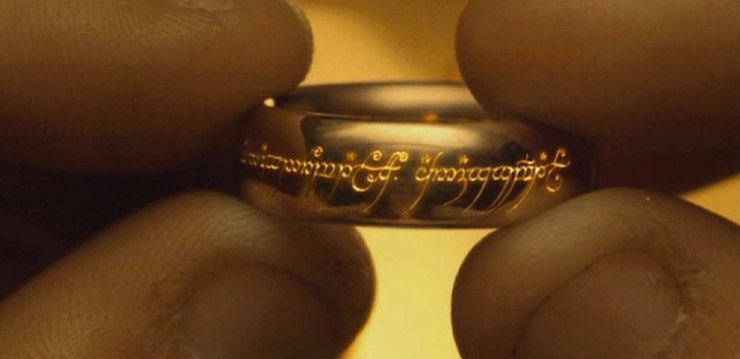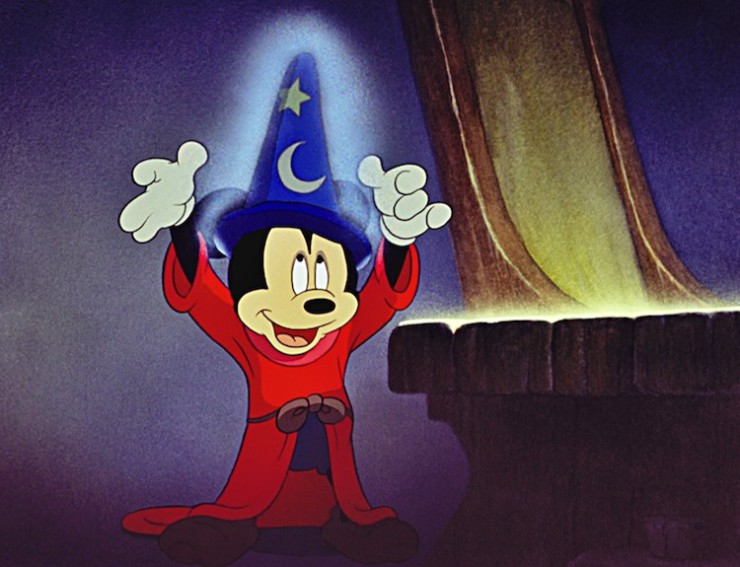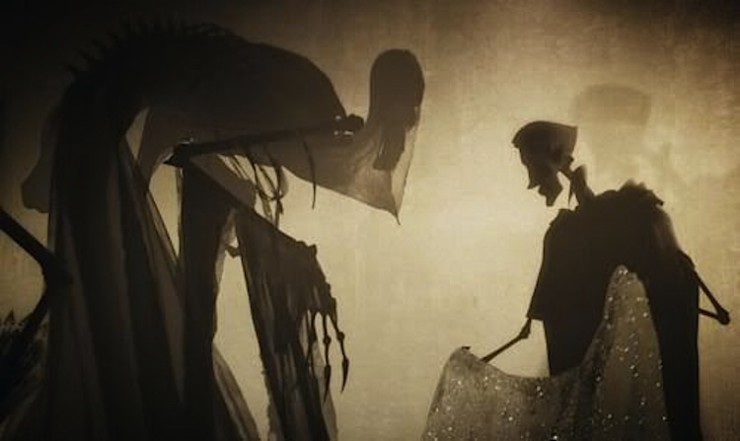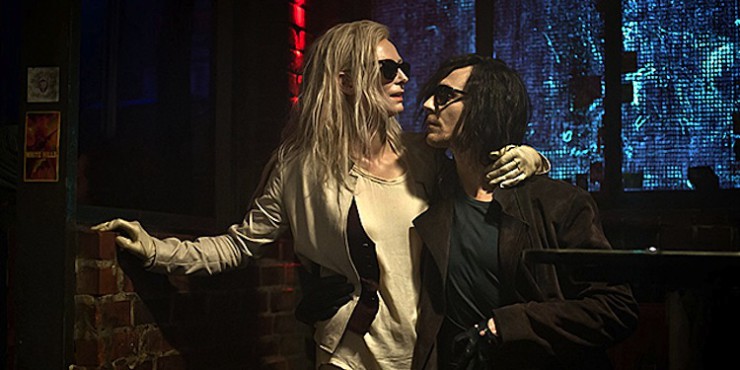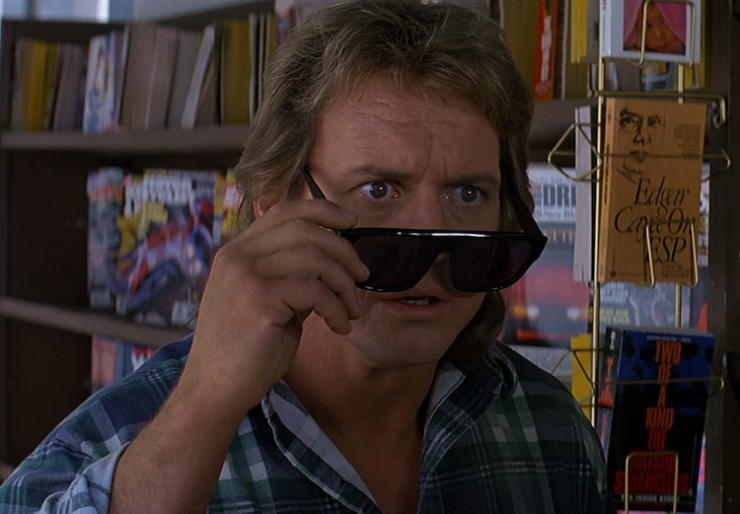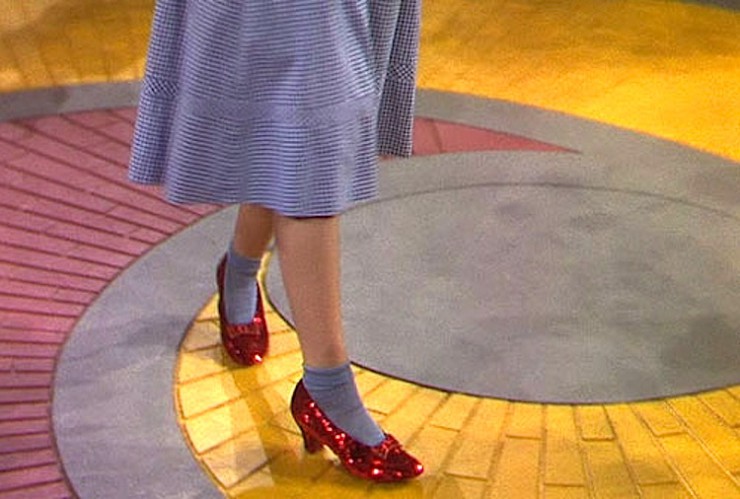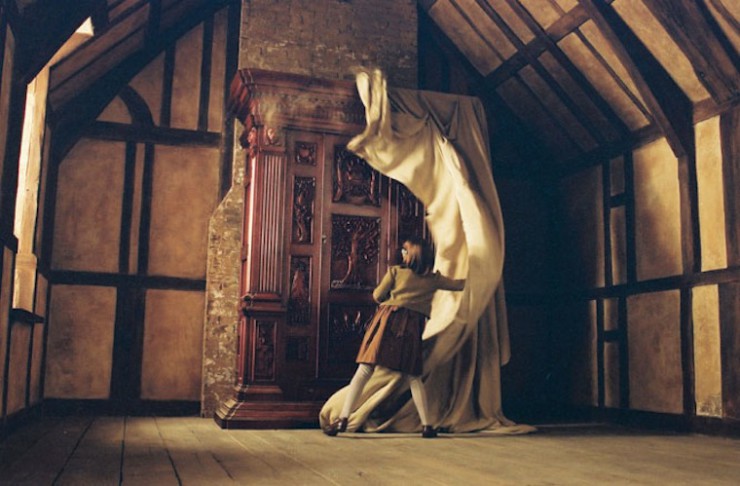What makes a world compelling? In fiction, piling on details about food, home decor, and clothing can be a quick way to introduce a reader to larger issues of class and gender roles. And particularly in genre literature, clothing and jewelry can be imbued with significance (and sometimes magic) that can turn the tide of a plot.
We’ve rounded up some of the most significant sartorial choices in all of science fiction and fantasy, but we wanted to start you off with that glorious image above, in which Donny Osmond’s teeth almost manage to outshine the Amazing Technicolor Dreamcoat itself. The original Coat of Many Colors landed Joseph in a pretty serious scrape, but it also led to adventure, an Andrew Lloyd Webber musical, and a classic Dolly Parton song. All of the clothes and accessories we’ve gathered here likewise either have great, story-altering significance, or act as catalysts to adventure!
Rings!
There’s only one way to start this post, and that’s with rings. Obviously, wedding and engagement rings have built-in significance, but instead let’s focus on two rings that do two very different storytelling jobs in fantasy. First, in Katharine Addison’s The Goblin Emperor, we join 17-year-old half-goblin Maia on the morning that he learns that his father and brothers have died, and he is now, unexpectedly, with no training, the Emperor. The next few months are a jumble of harsh lessons, horrifying learning curves, and lots of public humiliation, as he must learn to rule people who hate him as the mixed-race son of an unfavored Empress. Maia (and the reader) is offered a brief respite when he goes to commission his official signet ring. What could have been a silly shopping excursion becomes truly poignant when we learn that Maia’s mother designed a ring for herself, but was never allowed to use it, as her husband considered her family crest barbaric. Maia takes her ring as his own, and it becomes both a symbol of his love for her, and a declaration that he is not going to cave to his father’s supporters.
On the opposite end of the jewelry counter lies the One Ring. Originally written simply as a magic (if slightly suspect) ring of invisibility, Tolkien imbues it with a more malevolent and deliberate power throughout The Lord of the Rings—forged in the fires of Mount Doom, micromanaging the affairs of cursed kings, and longing ever to be back on the knobby claw of Sauron, it causes no end of trouble for Bilbo and Frodo Baggins, not to mention a poor unfortunate soul called Sméagol.
Hats!
Wizard’s hats are de rigeur in fantasy art, from Gandalf’s weather-beaten chapeau to Hogwarts’ scene-stealing song-smith, the Sorting Hat. But the majesty of the hat in Disney’s take on “The Sorcerer’s Apprentice” will not be denied: silvery blue, pointy, and bedazzled with glowing stars and crescent moons like so many children’s ceilings, Yen Sid’s fashion sense is not to be trifled with. Rather than a more traditional wand, here the hat itself seems to be the source of magic—Mickey, the lowly apprentice, is able to bring an inanimate broom to life simply by putting it on his head. But our mischievous hero soon learns that the hat’s power might be a little too much for him, as he can’t figure out how to stop the broom—not even brute violence does the trick. Instead it takes the master’s steady hand to set everything back to normal, and put the apprentice back in his place.
Of course, there might not always be a wiser wizard around to bail you out of trouble with your magical accessories. Case in point: the sad tale of Simon Petrikov, AKA the Ice King in Adventure Time. Simon discovers the crown while on an archaeological excursion somewhere in Scandinavia, and from that moment on is pretty much doomed. Unaware of its magical properties, he places the crown on his head as a joke and begins to hallucinate, arguing with the crown itself and often blacking out in the process. The crown grants him magical powers and protects him during the cataclysm of the Mushroom War, but it also begins to erode his personality and eventually destroys his memories of his original self, transforming Simon into the bumbling and occasionally frighteningly powerful Ice King.
Cloaks!
The Invisibility Cloak is the great stealth treasure of the Harry Potter series. At first it seems like just a perfect Christmas gift for a young boy—it’s perfect for venturing into the hallways, and since Harry is awesome, he immediately shares it with Hermione and Ron. It proves more and more useful as the adventure become more serious, but it transcends its initial role as a great magical item when Harry is forced to think seriously about how his dad had used it, and to reckon with the gap between his privileged, sometimes jerk father, and his own attempts at being a decent person. Finally, the cloak is revealed to (maybe, probably) be a Deathly Hallow, the counterpoint to the Elder Wand and Philosopher’s Stone. This underscores the entire tug-of-war between life and death throughout the series, personified in Harry’s choice to accept his death at Voldemort’s hands, rather than clinging to life and endangering his friends.
Jacqueline Carey’s Kushiel’s Legacy trilogy puts a lot of stock in what characters are wearing, and not wearing. One of the privileges of being an anguissette is that Phèdre is the only person allowed to wear a sangoire cloak, dyed a red so dark as to be almost black; it is a status symbol, and a way to recognize her as she moves through the City of Elua and the palace on her business. The cloak gains importance at the close of Kushiel’s Dart, when, after a book-long battle of wills, Phèdre loses it, only for her escaped nemesis/love interest Melisandre to send it back to her as a challenge. This leads to Phèdre’s choice to chase Melisandre down in Kushiel’s Chosen, with fallout both emotional and political.
In Alter Reiss’ Sunset Mantle, the mantle becomes a symbol for many things: the honor of the woman who made it, the hopes of the man who wants to buy it from her, and above all else, the beauty that can sometimes startle a hard world, and force them to fight for a better life. Cete is a career soldier whose old city had to cast him out; he comes to Reach Antach in search of a new life and an army to join. But on his way into the city, he is arrested by the sight of a beautiful mantle, that captures all the colors of sunset in embroidery like none he’s ever seen. Although the mantle has already been paid for by someone else, he stakes a large part of his future pay on a commission from its weaver, a blind woman named Marelle. When Cete finds himself trapped in a conspiracy, Marelle proves to be the only one he can rely on, and together the two have to choose whether to fight for a new life, or leave their home to certain ruin. See? If someone offers you a cloak, think long and hard before you accept.
Gloves!
What is it about gloves? For Rogue of the X-Men, who absorbs life- and psychic-energy through skin-to-skin-contact, gloves are a necessity to protect those around her. But without a physical need for such a barrier, gloves often mark people (and societies) as old-fashioned or rigid. In Only Lovers Left Alive, the removal of gloves marks the deepest intimacy, as the lovers of the title ask permission to bare their hands in front of each other. The citizens of the Radchaai in Ann Leckie’s Ancillary Justice (and its sequels) wear gloves as a matter of modesty—hands are seen as private at best, and downright icky at worst, so you keep them covered in polite company. Things are even more strict in Seth Dickinson’s The Traitor Baru Cormorant: Hands are covered at all times, and if you’re doing work that soaks and stain the gloves, you may swap them out for clean ones as quickly as possible—but the idea of doing anything barehanded is just not okay.
Glasses!
Are you impressed by Rowdy Roddy Piper’s shades? Rightfully so, as these sunglasses are a gateway to The Truth in John Carpenter’s classic, They Live. This pre-Matrix Matrix posits that Earth is being drained of its resources by a race of aliens who infiltrate all of our culture and media to encourage us to keep breeding and buying stuff while ignoring social inequity and environmental collapse. When Piper finds a pair of superpowered shades that allow him to see the world as it actually is, he joins a crusade to free humanity. Along the way, he tragically runs out of bubblegum, and hence must commence kicking ass.
However, these are not our favorite glasses in all of genre, because those sit awkwardly atop the nose of Margaret Murry. In an article about A Wrinkle in Time, Jen Doll states, “There was no one like Meg Murry before Meg Murry.” The glasses are a big part of that. She’s forever shoving them up her nose with a great deal more anger than is necessary, taking them off to polish them on woolen skirts, and removing them so only Calvin can see her eyes. They have no magical ability, but they mark her as a nerd in an early-1960s society that prizes popularity and conformity above all else. And given how often Meg ends up seeing truth that no one else does, we’re assuming that there might be a slightly metaphorical thing happening here.
Shoes!
Shoes figure prominently in three different female-centric tales. The Glass Slipper celebrates the beauty of Cinderella, and allows her true goodness to come through and be rewarded. The Red Shoes, on the other hand, er, foot, bring a curse with them. They’re purely vanity-punishment devices, until Powell-Pressburger got their hands on them in 1948 and created one of the greatest films of all time. And in an even more complex take, L. Frank Baum’s Silver Shoes/Ruby Slippers act as both catalyst, reward, and metaphor. Dorothy wins the shoes after committing manslaughter, and they become the catalyst for the plot, as the Wicked Witch of the West pursues Dorothy and her companions across Oz just to take them. They are also Dorothy’s transport home. In the Wizard of Oz film, this becomes a much bigger deal, as Oz is revealed to be a dreamworld. By clicking her beautiful ruby heels three times, Dorothy is saying goodbye to the life and color the shoes represent, and choosing to return to a family that is loving, yes, but also drab and literally black-and-white.
The Wardrobe!
Should this count? We think this should count. A wardrobe’s sole purpose is to contain clothing, after all, and the right clothing can always be a catalyst for adventure. But C.S. Lewis’ wardrobe goes above and beyond its personal call of duty by containing all of Narnia within it, and giving us the perfect portal for a portal fantasy. While the magical painting in The Voyage of the Dawn Treader is marvelous, and the train crash in The Last Battle is memorably rage-inducing, the titular piece of furniture in The Lion, the Witch, and the Wardrobe set a high bar for finding magic buried within banality. It also acts as a wonderful celebration of childhood: who other than a small, lonely kid would think to explore a wardrobe, and then entice her siblings to come in with her?
We’re sure we’ve left some important frocks off this list, so please rummage through your mental closets and let us know about them!










